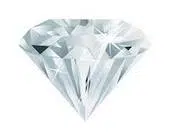 The etymological journey of the term diamond begins in the Greek adámas , which came to Latin first as adămas and then as diamas . This is the name given to the precious stone that presents crystallized carbon in a cubic structure , standing out for its hardness, transparency and brilliance .
The etymological journey of the term diamond begins in the Greek adámas , which came to Latin first as adămas and then as diamas . This is the name given to the precious stone that presents crystallized carbon in a cubic structure , standing out for its hardness, transparency and brilliance .
When a substance can present different molecular or atomic structures, it has the property known as allotropy . Molecules composed of a single element that have different structures are called allotropes .
A diamond, in this framework, is an allotrope of carbon . In this case, the atoms of this substance are arranged in a cubic crystalline system. After graphite , it is the most stable form of carbon.
The strength of the covalent bond that links its atoms makes diamond have great hardness and high thermal conductivity. This allows diamonds to have many industrial applications, in addition to a high value in jewelry.
The expression diamond in the rough is used to name the individual or object with a lot of potential, but that still requires development or polishing. For example: “This player is a diamond in the rough, although he still has to learn many things,” “Investors think that our company is a diamond in the rough.”
Precisely, the way in which we know the diamond in jewelry and ornaments is obtained after a long cutting process , which consists of the following five phases: cruising, sawing, roughing, cross cutting and polishing. Only after having performed these operations on a rough diamond (also called octahedral , given its appearance), is it possible to transform it into a cut one (or dodecahedral ), a job that requires a lot of dedication and precision.
Throughout the cruise phase, it is possible to divide the diamond into two parts. The first step is to draw a line on its surface, place a sheet of steel there and hit it dry. In this way, we obtain two portions more suitable for the following phases and we also eliminate crystallization defects, cracks or mirrors, inclusions and piqués, among other characteristics that are not accepted in a cut diamond.
Sawing also consists of cutting a diamond into two parts, for subsequent roughing or cutting. Unlike cruising, it allows us to keep the tips. Currently it is possible to use automated machines, both mechanical and laser, for this operation .
To round off the belt there is the roughing phase, which serves to define the final shape of the diamond before cutting it. There are two types of grinding machines, each suitable for a different size of stone.
 During cross cutting we generate the facets of the diamond, something that requires a combination of skill and experience. Generally, there are three people who undertake this phase and the last one, polishing, which consists of smearing the stone with an abrasive product and rubbing it against a disc until achieving an absolutely polished result.
During cross cutting we generate the facets of the diamond, something that requires a combination of skill and experience. Generally, there are three people who undertake this phase and the last one, polishing, which consists of smearing the stone with an abrasive product and rubbing it against a disc until achieving an absolutely polished result.
The French deck , on the other hand, has a suit called diamond. The cards in this group have red rhombuses that symbolize diamonds.
In countries like Venezuela , Mexico and Cuba , the inner sector of the field used in baseball games is called a diamond. It is a quadrangular-shaped area, at whose vertices are located the bases that the players who are in offensive action must try to reach.
Diamante , finally, is the name of a department and a city in Argentina , belonging to the province of Entre Ríos .
